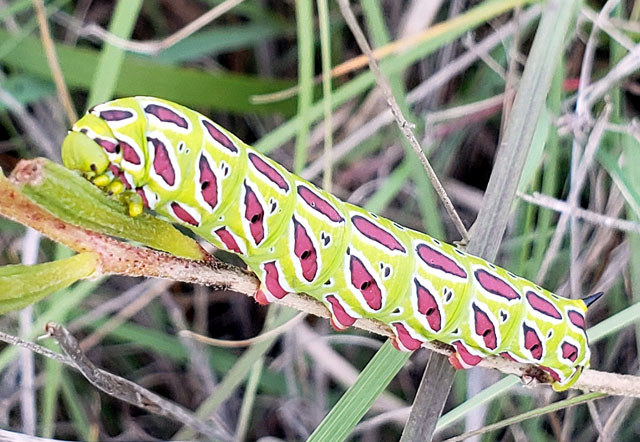Sphinginae subfamily
Sphingini tribe:
 |
Agrius cingulata,
WO Pink-spotted hawkmoth. Larvae feed on plants in the Convolvulaceae family, especially
Ipomoea batatas (sweet potato) and in the Solanaceae family,
especially (Datura) (jimsonweed) and related plants in the
Americas. There is also a brown form. Look for very large, dark
spiracular circles.
|
 |
Ceratomia amyntor
WO,
the Elm Sphinx or Four-horned Sphinx.
Larvae feed on Elm (Ulmus), birch (Betula), basswood
(Tilia), and cherry (Prunus).
There are both green and brown forms. The four horns near
the head are diagnostic. Now confirmed by Bob Heckman, September 23, 2007.
|
 |
Ceratomia catalpae
WO,
the Catalpa Sphinx.
Young caterpillars feed gregariously on Catalpa species
(Catalpa bignoniodes and C. speciosa) in the
Bignoniaceae family, skeletonizing the foliage.
Larvae are mostly white in early instars.
generally more eastern species
|
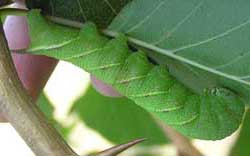 |
Ceratomia hageni
BAMONA: Marshall, Hagen's Sphinx or Osage Orange Sphinx.
Larvae feed on osage orange (Maclura pomifera), and they have a granulous appearance with variable amounts of purple
along the oblique white stripes.
|
 |
Ceratomia undulosa
BAMONA: Johnston, the Waved Sphinx.
Fraxinus, Ligustrum, Quercus, Crataegus and
Chionanthus virginicus are listed as hosts..
In the fifth instar, the spiracular ovals are decidedly red and the
anal horn is off-white to pinkish laterally.
|
 |
Dolba hyloeus
WO; generally more easterly, Pawpaw Sphinx.
Pawpaw (Asimina triloba), littleleaf sweetfern
(Myrica aspleniifolia), possum haw (Ilex decidua), and
inkberry (Ilex glabra) as well as Tall Gallberry Holly
(Ilex coriacea).
Louis Handfield reports larvae probably feed on Ilex verticellata
in Quebec.
|
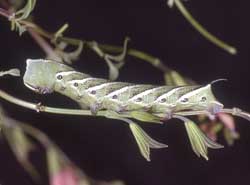 |
Lintneria eremitoides WO. Larval hosts are Sage (Salvia species).
Larvae will most often be encountered on Lamiaceae: Salvia (Sage), Mentha (Mints), Monarda (Beebalm),
Hyptis (Bushmints); Verbenaceae: Verbena, Lantana camara (shrub verbenas or lantanas).
One is even more likely to discover larvae feeding in the evening or after dark.
|
 |
Manduca quinquemaculatus
WO,
the Five-spotted Hawkmoth.
The caterpillars are called Tomato Hornworms and each has a black horn at the end of the abdomen.
Larvae feed on potato, tobacco, tomato, and other plants in the
nightshade family (Solanaceae).
|
 |
Manduca rustica
WO Rustic Sphinx.
Caterpillar (rare black form) has numerous white nodules on top of thorax and
seven pairs of oblique, blue-gray stripes along body side.
Horn white base; blue-gray at tip. Many hosts are utilized.
|
 |
Manduca sexta
BAMONA: Garvin; Bryan, the Carolina Sphinx.
Tobacco Hornworms, equipped with a red-tipped horn at the end of the
abdomen, are true gluttons and feed on tobacco and tomato, and
occasionally potato and pepper crops and other plants in the
nightshade family (Solanaceae).
|
 |
Paratrea plebeja
WO , the Plebeian Sphinx.
Preferred hosts are common trumpetcreeper (Campsis radicans),
Florida yellow-trumpet (Tecoma stans), lilac
(Syringa species), and
passionflower (Passiflora species).
The anal horn is blue, preceded by a yellow dash.
|
 |
Sphinx chersis
WO, Northern Ash Sphinx or Great Ash
Sphinx. Larvae are pale bluish green. Head has pair of
yellow lateral bands meeting at apex. Oblique, lateral
stripes are pale, bordered anteriorly with darker green.
Ash, lilac, privet, cherry, and quaking aspen.
|
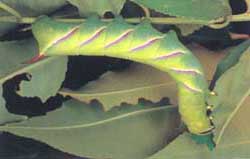 |
Sphinx drupiferarum
WO,
the Wild Cherry Sphinx.
Sphinx drupiferarum larvae hide in the day and feed primarily on
cherry, plum, and apple at night.
Larvae have been found on Amelanchier nantuckensis in
Massachusetts and have been reared to pupation in Michigan on
Prunus serotina from eggs readily oviposited by a female.
possibly
|
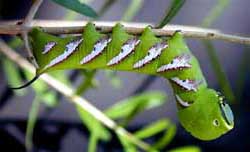 | Larvae feed on New Mexican forestiera
(Forestiera neomexicana), on Forestiera angustifolia
and on little leaf ash (Fraxinus gooddingii) in the Oleaceae
family. There are green and dark forms and all larvae tend to darken
just before pupation.
|
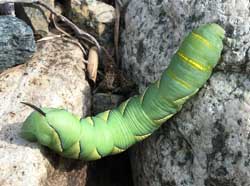 |
Sphinx vashti
WO, Snowberry Sphinx.
Mature larvae are green with seven pairs of lateral, white, oblique
bands which are bordered anteriorly with black. The anal horn is
smooth and black. Larvae feed on the common snowberry
(Symphoricarpos albus) and on coralberry (S. orbiculatus).
Note the raised gold bands on thorax.
|
Smerinthini Tribe:
 |
Amorpha juglandis
BAMONA,
the Walnut Sphinx.
Amorpha juglandis larvae feed upon Walnut and butternut (Juglans),
hickory (Carya), alder (Alnus), beech (Fagus),
hazelnut (Corylus), and hop-hornbeam (Ostrya).
|
 |
Pachysphinx modesta
WO,
the Modest Sphinx or Poplar Sphinx.
Larvae feed on poplars and cottonwood.
|
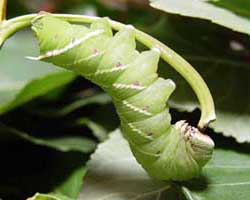 |
Pachysphinx occidentalis
BAMONA: Bryan,
the Big Poplar Sphinx.
This one is quite similar to Pachysphinx modesta, with modesta
being smaller and darker both as larvae and adults.
Pachysphinx occidentalis eggs are
quite large and a translucent pale green.
Larvae, relatively stout, feed on cottonwood and poplar (Populus) and willow
(Salix), and have a white horn.
unlikely possibility
|
 |
Paonias excaecata
WO,
the Blinded Sphinx.
Larvae accept willows, birches, and cherries.
I have also found them in the wild on oak in eastern Canada.
generally more eastern species
|
 |
Paonias myops WO,
the Small-eyed Sphinx.
Wild cherry species are the favorites as larval foodplants, but eggs
will also be deposited on birches and other forest trees.
To the left a second or third instar larva rests on pin cherry. The
"red heart" marking readily identifies this species. There can be varying
degrees of lateral red markings.
|
 |
Smerinthus jamaicensis
BAMONA: Bryan,
the Twin-spotted Sphinx.
Larvae feed upon many forest trees including birches and cherries,
but are expecially fond of poplars and willows. Red markings on sides
vary greatly from specimen to specimen.
|
Macroglossinae subfamily
Dilophonotini tribe
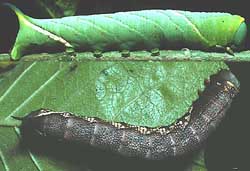 |
Aellopos titan
WO, the Titan Sphinx.
Larvae feed on seven year apple, Casasia clusiifolia, common
buttonbush, Cephalanthus occidentalis, and white indigoberry,
Randia mitis. Randia monantha, Randia aculeata,
Albizzia adinocephala and Randia grandifolia, all in the
madder family (Rubiaceae), also serve as hosts.
rare
|
Erinnyis domingonis
WO, the Dominican Sphinx.
This moth flies in Haiti and Jamaica south to Paraguay and Bolivia
with occasional sightings in Texas and Arizona. This species
might be present in Oklahoma County as a
very rare stray. Sorry, no larval image
available at this time.
|
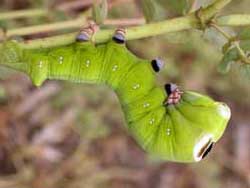 |
Erinnyis ello
WO, Ello Sphinx.
Papaya (Carica papaya), Cnidoscolus
angustidens, poinsettia (Euphorbia pulcherrima),
guava (Psidium species) and
saffron plum (Bumelia angustifolia/Bumelia celastrina).
Manilkara bahamensis,
Willow Bustic (Bumelia salicifolia)
and Painted Leaf (Poinsettia heterophylla) are also hosts.
Nice socks! Larvae show considerable variation.
|
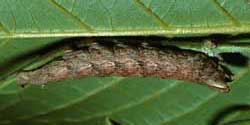 |
Erinnyis obscura, Obscure Sphinx,
WO.
Larvae feed on Rauvolfia ligustrina, Rauvolfia tetraphylla,
Stemmadenia obovata, Philibertia, Cynanchum, papaya
(Carica papaya), Asclepiadaceae, Blepharodon mucronatum,
White vine (Sarcostemma clausum) and Morrenia odorata.
rare
|
|
 |
Hemaris diffinis
BAMONA: Johnston; Carter; Pontotoc; Garvin; Bryan,
Snowberry Clearwing or Bumblebee Moth.
Snowberry (Symphoricarpos),
honeysuckle (Lonicera), Coralberry, viburnums, Blue Dogbane
(Apocynum) and dwarf bush honeysuckle (Diervilla lonicera).
Horn is black with a yellow base.
|
 |
Hemaris thysbe
WO, Hummingbird Clearwing.
There is also an orangey-pink prepupal form. The lateral line runs
from S1 to the blue horn.
Hemaris thysbe larvae feed on viburnum and related plants.
generally more eastern species
|
Philampelini tribe:
 |
Eumorpha achemon
WO,
the Achemon Sphinx.
Larvae feed upon Grape (Vitis), Virginia Creeper
(Parthenocissus quinquefolia) and other vines and ivies
(Ampelopsis).
Larvae occur in both a light (green) form and a darker (tan/brown)
form. Note six "segmented" oblique lines.
|
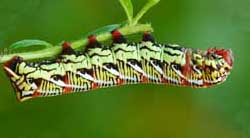
|
Eumorpha fasciatus
WO, Banded Sphinx.
Larvae feed upon primrose-willow, Ludwigia (water primrose)
and other plants in the evening primrose family. This hornless larva is
highly variable. Look for large, dark spiracular circles and a dark
line in the center of the back.
|
Eumorpha labruscae Gaudy sphinx: Garvin
 |
Eumorpha pandorus
BAMONA, the Pandorus Sphinx.
If you have Grape or Virginia Creeper nearby, then you might encounter
this species.Note the five large white ovals. There are
orangey-brown and green forms also.
generally more eastern species
|
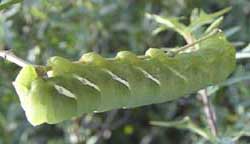 |
Eumorpha vitis
WO,
the Vine Sphinx.
Eumorpha vitis vitis larvae feed upon grape foliage (Vitis) and
other vines (Cissus): Cissus pseudosicyoides
and Cissus rhombifolia and Cissus sicycoides.
I suspect there would be a brown form.
Note five, smooth, narrow, oblique white lines.
|
Macroglossini tribe
 |
Amphion floridensis
WO,
the Nessus Sphinix.
In additon to Virginia creeper larvae accept Grape (Vitis),
ampelopsis (Ampelopsis), and cayenne pepper (Capsicum).
Larvae are green until the final instar.
|
 |
Cautethia spuria
WO; unlikely adult stray,
the Spurious Sphinx
Larvae feed on
Coutarea hexandra, Chiococca alba and
Chiococca pachyphylla and probably other species of the Rubiaceae family.
rare stray; varied larval forms
|
 |
Darapsa choerilus
WO, the Azalea Sphinx.
Larvae feed on Azalea and Viburnum and progress very rapidly. The
larva to the left on Viburnum cassinoides is getting ready to
pupate. Color change from green to light burgundy-brown indicates
pupation is imminent.
|
 |
Darapsa myron
BAMONA: Marshall, the Virginia Creeper Sphinx or the Grapevine Sphinx.
If you have the foodplants indicated in the common names, you probably have this species nearby. The lower wings are orange.
Larvae feed on Virginia creeper (Parthenocissus quinquefolia), Grape (Vitis), Ampelopsis, and Viburnum.
|
 |
Deidamia inscriptum
BAMONA: Marshall,
the Lettered Sphinx.
Females lay translucent green eggs singly on leaves of the host
plant. Grape (Vitis), ampelopsis (Ampelopsis), and
Virginia creeper
(Parthenocissus) all serve as larval hosts.
|
 |
Hyles lineata
BAMONA: Atoka, White-lined Sphinx.
Larvae are highly varied and feed on a great diversity of plants
including willow weed (Epilobium), four o'clock (Mirabilis),
apple (Malus), evening primrose (Oenothera), elm
(Ulmus), grape (Vitis), tomato (Lycopersicon),
purslane (Portulaca), Fuschia.
All larvae seem, however, to have the red/black swellings split by
dorso-lateral lines.
|
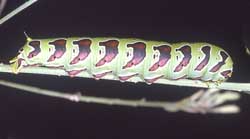 |
Proserpinus guarae
Jona A. Tucker: Johnston,
the Proud SphinxLarvae feed on (Onagraceae) including evening primrose
(Oenothera), gaura (Gaura), and willow weed
(Epilobium).
rare
|
Proserpinus guarae larva, June 4, 2018, Jona A. Tucker; John Fisher
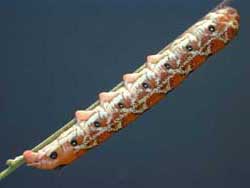 |
Proserpinus juanita
BAMONA: Bryan,
the Juanita Sphinx.
Newly-hatched caterpillars eat their eggshells. Larvae feed on
(Onagraceae) including evening primrose (Oenothera), gaura (Gaura),
and willow weed (Epilobium). Michael Van Buskirk has found them on
Guara biennis in Missouri. rare
|
 |
Sphecodina abbottii WO; unlikely, generally more easterly, Abbott's Sphinx:
Larvae feed at night on grape (Vitis), ampelopsis
(Ampelopsis), hide on bark during day. Virginia creeper. Also dark form
without green patches. Note "raised eye", replacing anal horn.
generally more eastern species
|
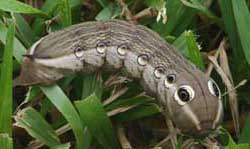 |
Xylophanes tersa
WO,
the Tersa Sphinx.
Larvae also feed on Borreria, Catalpa and Manettia spp. and
Smooth buttonplant (Spermacoce glabra) and starclusters
(Pentas species). They are also recorded on joe-pie weed and
Hamelia patens and on Hedoydis nigricans. The green form may be more
common.
|
|
